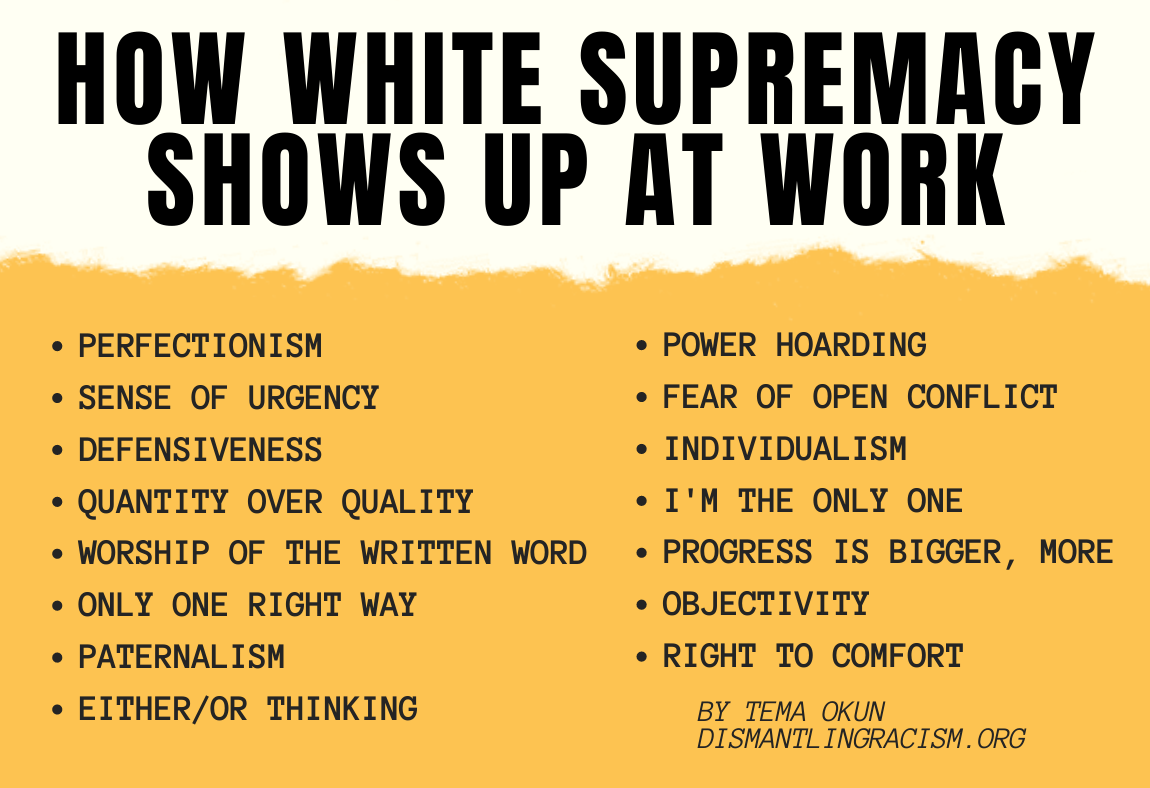

We invite other people’s feedback and then proceed with our version of what’s best. We invite people to collaborate without explicitly naming who holds the power as a decision maker. One effect of patriarchy is that white women have a complicated relationship with power, which leads to regularly denying/ignoring/downplaying how much power we hold. I believe the following patterns are an important part of the story about why a sector that aims to do good so often falls short of its vision. In other instances, it’s taken me years to see the impact of my behaviors. Sometimes, I heard what folks were trying to tell me. My own behavior reflects these patterns and has perpetrated harm in ways I did not comprehend in the moment. Naming these patterns is not about calling out other white women or distancing myself from whiteness. Oftentimes, I could feel in my body that something wasn’t right, but I lacked the language to connect what was happening to deeply entrenched patterns of white supremacy. In the spirit of Tema Okun and Kenneth Jones’ foundational and critically important work on characteristics of white supremacy culture, I’ve compiled a list of characteristics that I have both observed in other white women and have participated in myself with insidious consequences. Historically, AMKRF has been led exclusively by white women and remains a disproportionately white staff. I am a white, queer woman, a Southerner, with the disposition, education, and credentials that are (over)valued in these sectors. Over the last two decades, I’ve worked in education and nonprofits, spaces where white women disproportionately occupy positions of leadership. Oftentimes, the racism white women perpetuate is less visible, but it is dangerous to think that it is less pernicious.Īs our analysis of white supremacy has grown, I’ve found myself asking what are the everyday ways white women show up that maintain white supremacy in a sector that is, ostensibly, about making the world a more just place. White supremacy and patriarchal gender norms converge to create a toxic slurry of behaviors that impact what white women’s racism looks like. White women do white supremacy…differently. Since the violent Charlottesville protests, images of white nationalists are a daily part of our media landscape, but these pictures are dominated by the faces of white men, who unapologetically display their violence, rage, contempt.

As we’ve shared, AMKRF has been reflecting on how white supremacy is reflected in our organizational culture and structure. Unpacking white supremacy culture –how it shows up in our organizations, in our homes, in our words, and in our thoughts–transcends surface level analysis about equity. Being able to identify and name the cultural norms and standards you want is a first step to making room for a truly multi-cultural organization.” Kenneth Jones and Tema Okun*** As a result, many of our organizations, while saying we want to be multicultural, really only allow other people and cultures to come in if they adapt or conform to already existing cultural norms. “One of the purposes of listing characteristics of white supremacy culture is to point out how organizations which unconsciously use these characteristics as their norms and standards make it difficult, if not impossible, to open the door to other cultural norms and standards.

As a part of our work, we are sharing reflections about what we’ve learned in the process of building relationships with one another and analyzing power, white supremacy, oppression, alongside liberation. During our “ pause for the cause ,” AMKRF has entered a time of organizational reflection and analysis building.


 0 kommentar(er)
0 kommentar(er)
